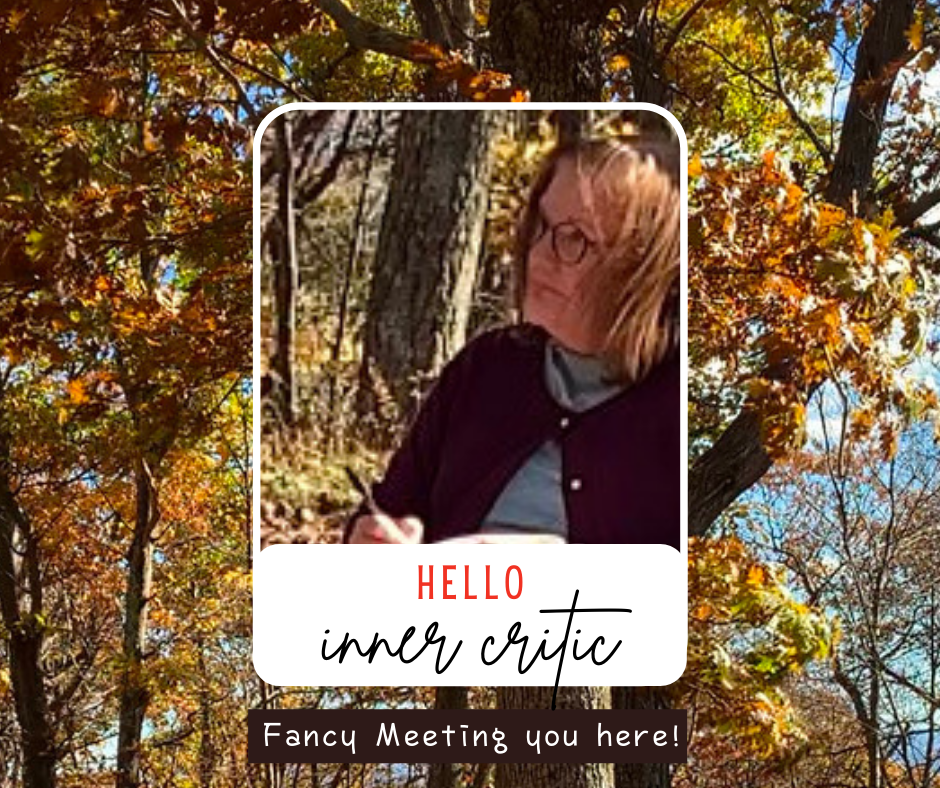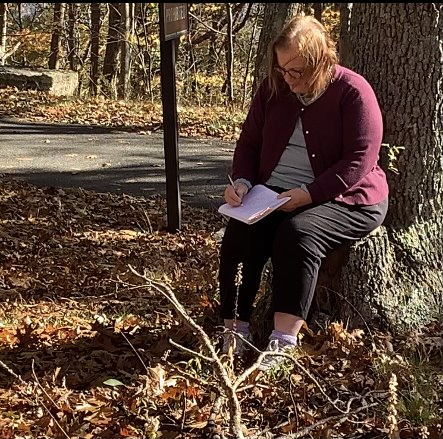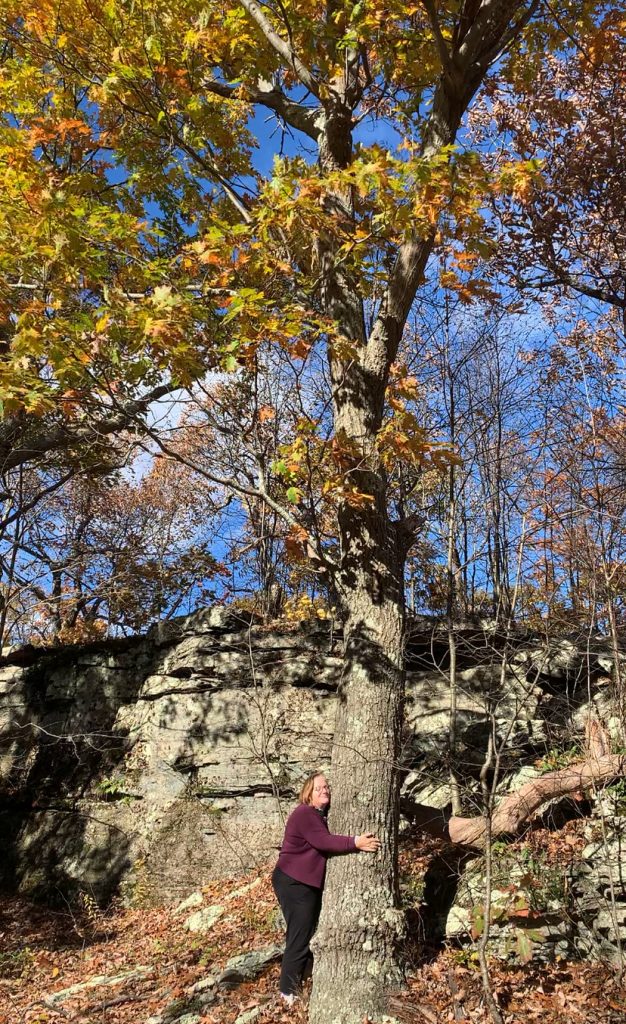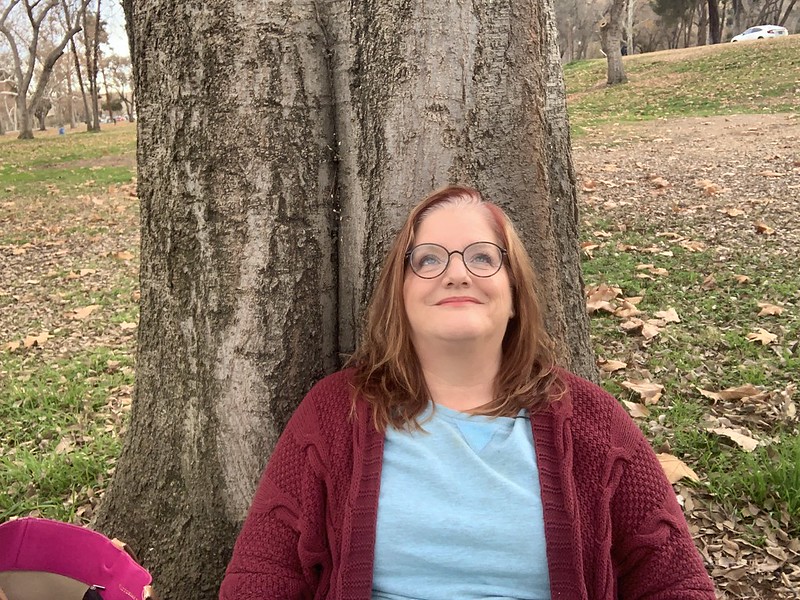
Forest bathing is one of the most pleasant experiences anyone may enjoy – it doesn’t require equipment or skills or new shoes. All it requires is one have a willingness to be in a wooded area – a forest or park – even an urban park or a back yard with numerous trees will work. The technical definition (if you don’t know it yet) will show up later.
Last Monday, I visited High Point State Park in Sussex County, New Jersey which is where I am living right now. I brought my notebook with me to possibly write, but that was a second part of the plan. The true plan was to be with trees and hug a tree or two for good measure.
How did I end up laughing in the Forest with my Inner Critic?
Even as I typed the words “Laughing in the forest with my inner critic” I realized how foreign or flat out wrong this may appear to some people. Who laughs with the villain?
Who chuckles with the one who makes us feel unworthy of praise?
Admittedly as a writer and as a writing coach, I have some unconventional ideas – and trusting the process is one of them. Stay with me as the story unfolds.
These moments among the trees were like a tree fest of profound, beyond language joy. Gratitude is a close description and the feelings were – if possible to understand – so much more than simply gratitude.
Definition of Forest Bathing.
My plan was to do some forest bathing and tree hugging. What is forest bathing? National Geographic defines it like this: “The term emerged in Japan in the 1980s as a physiological and psychological exercise called shinrin-yoku: “forest bathing” or “taking in the forest atmosphere”.
I brought my notebook “just in case” it felt right.
There, in the forest, I came upon a companion black oak tree which invited me to take a seat on a makeshift stool and experience forest bathing with words.
This is where my inner critic (or perhaps the spirit keeper of the woods) stepped in when the very first two words off the tip of my pen were “majestic oak.”
Smack! I felt the energetic sting of a ruler on my pale, bent fingers cradling my trusty writing utensil. I kept my head lowered as I mumbled, “I know. Horrid. What was I thinking?”
This is when my Inner Critic and I started laughing.
My inner critic was being helpful. That’s what editors do, after all, they make our writing better.
How often do writers trot out the most maligned and overused meaningless words in the beginning of their writing?
Here I was, sitting in a forest surrounded by oaks of orange, brown, and assorted mottled spotted leaves. There were enormous green-yellow leaves on baby oaks that didn’t seem capable of bearing the weight of them. Deep blue sky over head with wispy clouds like smoke from candles that have been blown out. Leaves, sounding like foam on the Atlantic’s waves or perhaps imitating rocks on the flow of the river.
Here an oak, there a beech, similarly covered with lichen.
It was possible, when I close my eyes, to smell the leaves returning to soil.
I noticed there wasn’t evidence of many other feet walking here in recent days.
My focus pulls aside when I turn toward the hum of a truck on the highway. After the truck I notice the hum of a small airplane, a motorcycle, a sports car.
The trees patiently wait for me to notice them again.
The tallest yellow tree, an eastern oak, seemed to call out to me.
“Let people know we are here,” he said, seeming to give my notebook and pen a half nod. “Let people know we are grateful for when they visit us and sit a while.”
Looking more closely, I see signs of a broken bough, a torn branch or two up his spine. This tree, like me, is healing and whole at the same time.
Just like I am healing and whole at the same time.
Just like so many writers and creatives are both healing and whole at the same time.
Somtimes that wholeness is when we are able to laugh when our inner critic gets it right and she becomes a collaborator. Special note: you are best knowing how to write free flow style well before you allow the inner critic to interject her corrections and suggestions.
One of the reasons I was able to shift gears into better writing was because I knew my word choice was tired and cliche almost as soon as they tumbled off the tip of my pen. I didn’t respond to the appearance of the tired, cliche words with a gasp or a barrage of negative self talk, I laughed.
What would happen if you decided to play with your inner critic instead of making your inner critic wrong?
The most effective way to work WITH your inner critic
The single best thing you can do is give your inner critic space to help you AFTER your first draft is complete, after you have allowed your words to flow wherever they wanted to flow – even if the first words are trite and cliche.
Did it occur to you if my inner critic hadn’t showed up and overstepped her boundaries while I was forest bathing, you would not be reading this? Maybe YOU are the exact reason she showed up with me while I was minding my own business, enjoying nature with my notebook and pen in hand.
Consider this an invitation to take your notebook outside and find some trees to spend time with soon. Bring an open mind and heart. Enjoy finding words that fill you with delight as much as the experience fills you with delight.
Reach back here and tell me when your mission is accomplished, please.
Julie JordanScott is a multipassionate creative who delights in inviting others into their own fullhearted, artistic experience via her creativity coaching individually or in groups, courses and workshops. To receive inspiring content and videos weekly and find out more about Coaching, Courses, Challenges and what’s going on in the Creative Life Midwife world? Subscribe here:
Follow on Instagram to Watch IGTV exclusive videos, stories and posts about writing and the creative process.
Let our Words Flow Writing Community: the only one missing is you! Join us in the Private Writing Group by clicking here.


